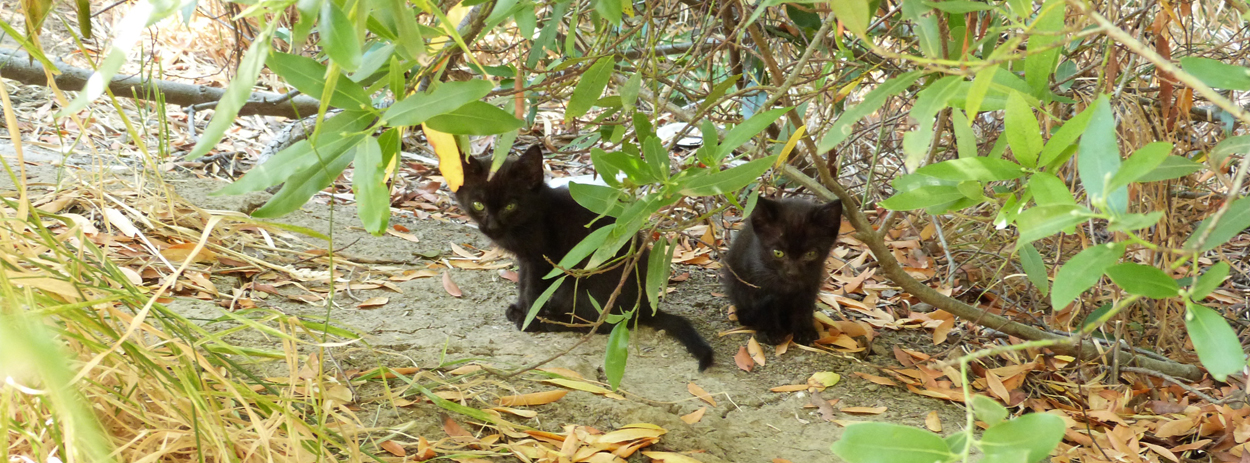Orphaned Kitten Care

Year after year we receive phone calls from individuals who have found a litter of abandoned kittens, want to help them, but don’t know how. The information provided here is meant as a tool for caring for these motherless kitties. If you live in Napa County and are not able or willing to give the kittens the care that they will need, please contact the Napa County Animal Shelter at 707.253.4382. Please note that the information provided below are guidelines for care but it is recommended to have the kittens seen by a full service veterinarian to ensure that they are in good health.
Before assuming kittens have been abandoned, wait and watch from a distance (about 35 feet away) to see if the mother returns. The ideal situation would be to trap the mama cat and the kittens so that the mom can continue feeding and caring for her young. But if there is no mama to be found then follow the steps below for caring for the orphaned kittens.
Introduction
Kittens under the age of 8 weeks need a mother- either a cat or a human surrogate. The following guidelines will help you with the care of your kittens.
- An orphaned kitten could potentially carry illness into your home that could affect your resident animals’ (or humans’) health.
- To protect people, young children should not handle the kittens and everyone should wash their hands after handling animals, fecal waste, or litter boxes.
- To protect other cats, the orphaned kittens should be separated from household pets for at least two weeks. This means that you should also prohibit the sharing of food and water bowls, litter boxes and toys.
- Kittens should be de-flead before they enter your home and as often as necessary to keep fleas off of them, because fleas can spread disease among cats and to people.
- You should wash your hands with soap and water before handling your own animals or children and you may also want to change clothes.
- You should routinely disinfect the kittens’ quarters.
- The best way to disinfect the area is to remove all organic material and fecal debris and then soak with a mild bleach solution (1 part bleach to 32 parts water) for at least 30 minutes. All surfaces, bowls, toys etc need to be disinfected (so you probably want to keep kittens in a room without carpeting, hardwood floors and so forth).
- It is best to have only one litter at a time rather than constantly adding new kittens in with others. Keeping them in cohorts allows you to prevent disease mixing among cohorts and to disinfect between groups.
- It is possible even with these precautions that resident cats could be exposed to mild infections such as URI.
Supplies you will need before you bring home kittens
- Box or carrier. You may want to use the carrier in which you took the litter home. It will provide a familiar-smelling, dark, quiet home for your foster kitties. However, a bigger box may be desirable, as it will allow you to see in, as well as provide plenty of room for the growing litter of kittens.
- Newspapers. Keep several layers in the bottom of the box, and they will come in handy when the kittens start to roam around the room and into their litter box.
- Small litter box for kittens. An oblong cake pan is perfect. Cut-off cardboard boxes also work well.
- Cat litter. Any non-clumping variety of litter will be fine. The clumping litter may be dangerous if ingested by a kitten.
- Water bowls. Heavy and impossible to tip. Should be stainless steel or porcelain/ceramic, NOT plastic, as plastic is difficult to disinfect because it is so porous.
- Food bowls (at least 2). One is for the eat-at-will dry cat food, the other for canned food. You can use TV dinner trays, paper plates or whatever you have; any relatively flat plate or saucer will do. The larger the litter, the larger the plate should be so that no one gets crowded out.
- Food. You should have both dry kitten chow, canned cat food (any brand for adults or kittens), and all-meat baby food (must not contain vegetables or onion powder). Offer several choices to weaned kittens to determine their preferences.
- Heating pad, hot water bottle, or infrared lamp. Unless the nursery is at least 85° and your kittens are 2 weeks or older, you need to supply extra heat. BE SURE THAT THE KITTENS HAVE ROOM TO MOVE AWAY FROM THE HEAT. For instance, if you are using a heating pad, place it under a towel so that it covers only half of the floor area of their box. The heating pad should be on “low” or “medium.” If you use a hot water bottle, keep it where cats can’t destroy it with their claws.
- Clean towels and blankets
- Toys. Plastic, disinfectable toys are good to reuse for new litters. Kittens can also amuse themselves with empty toilet paper rolls. Empty 12-pack cardboard soda boxes are good for an inventive number of games. Clean tennis balls, old stuffed socks, caps from soda bottles and paper bags are marvelous toys as well. Young kittens do not respond to catnip. Kittens will also “play” with anything they can find. Drapes, lamp shades and crystal ornaments are as much fun as the toys listed above. Be sure to “kitten-proof” your home. As they grow, their climbing abilities will develop, so anything irreplaceable should be kept out of reach!
- Scale. Although not critical to success, a food or postal scale will be very helpful in monitoring small kittens’ growth, which averages 4 ounces a week.
General care of kittens
- Young kittens should be kept in a large box or cat carrier lined with a towel for easy cleaning. It is very important to keep the kittens warm, and a heating pad is ideal for this. The heating pad should be placed under HALF of the towel (so they can move away from the heat if they need to) and set on “low.” The more kittens in your litter, the better able they will be to keep warm by sleeping together in a heap. Small litters and singletons need more help keeping warm. Keep kittens away from heaters or cold drafts.
- If kittens are not urinating and defecating on their own (when they are less than two weeks old), they will need to be stimulated. This should be done every few hours (often right after feeding) by gently rubbing a warm wet paper towel on the kittens anus and genital area. They will pee and poop into the paper towel.
- Keeping kittens clean. A mother works hard to keep her kittens clean, grooming them thoroughly to remove any sticky messes they may get into, such as kitten food or feces. Keeping kittens clean in the absence of their mother can be a messy business, but it is extremely important.
A flea comb will get rid of dried feces in the fur. You can also stroke a kitten with a warm, damp cloth, using short strokes to mimic a mother’s tongue. Be sure to dry him well so he can’t chill. Sometimes cat litter and dried feces can become caked on the underside of the tail or between the kitten’s toes. This may be softened and removed by dipping the kitten’s back end into a basin of warm water. Many kittens will not even notice that they are partially wet, but some will protest violently, and scramble to escape, so beware of sharp little claws!
Proper socialization
Any introductions of cats to other cats or cats to dogs should be made with great care and under constant supervision. Part of your job is to convince the kittens that humans are kind and loving. Outgoing, friendly kittens can be cuddled and played with freely, after spending a day or so to accustom themselves to a comfy box in a quiet room. Shy kittens will need more encouragement. Try sitting on the floor with a kitten held against your chest, supported underneath, and facing outwards, so he can’t see how big and scary you are. Stroke him and speak gently, telling him how cute and brave and fabulous he is (kittens love to hear that!). Continue this for about 30 seconds, then put him down before he starts squirming. You want this to be a pleasant experience. The kitten will not be impressed, but if you cuddle him often enough, he will learn to love it. Sometimes holding a pair of kittens helps – they seem to reassure each other.
Feral kittens are a special challenge to socialize. The earlier feral kittens separate from their mother, the more likely they are to adapt to people. Even at six weeks, feral kittens can act like little tiger cubs. If your kittens are fearful and run away when you approach, try sitting or lying quietly on the floor near them and let them come to you. Spend time quietly in their presence to get them accustomed to your company. Stroke them and talk to them gently while they are eating to further reinforce positive associations. After eight weeks of age, some people put kittens into solitary confinement briefly, which has the effect of making them very lonely and more willing to take comfort from a human. If they have the company of another cat, they are more likely to hide from you with the other cat. However, this practice can be cruel if the kittens are isolated for prolonged periods (more than a day).
There is no such thing as a “bad” kitten. Even if your litter doesn’t enjoy being held and cuddled, if they will tolerate being stroked and don’t cower under the sofa, they will make someone a wonderful pet. Not everyone wants an affectionate lap-cat. Many people prefer cats who are more independent and somewhat aloof companions.
Also, it is useless to punish a “naughty” kitten. Their little minds do not grasp deductive reasoning. Try distracting a mischievous kitten with something else until he forget whatever he was doing (it should not take long!).
Maintaining healthy growth of kittens
Commercially available kitten formula should be given at the kitten’s body temperature, about 100 degrees. Once the can is opened or the powder reconstituted, unused formula should be kept refrigerated and discarded after 24 hours. NEVER give a kitten cow’s milk (or anything else besides the specified formula).
It is best to feed the kittens one-by-one, and on a counter-top – this allows them to feed with all four feet on the counter, and their heads level, much as they would if they were nursing from their mom. Some kittens prefer to nurse standing on their hind legs while holding the bottle. They will require a little support from you in this position. Gently open a kitten’s mouth with one finger and place the tip of the nipple on his tongue. If he won’t eat, try stroking him. Pull lightly on the bottle to encourage vigorous sucking. Be sure to tilt the bottle up slightly to prevent the kitten from inhaling too much air. Do not force the kitten to nurse, or allow him to nurse too fast. Avoid feeding a kitten while he is cradled on his back – if the fluid goes down the wrong way, it may end up in his lungs. After each feeding, the kitten should be burped. Hold him against your shoulder and gently massage his back or pat it lightly.
Overfeeding is as dangerous as underfeeding kittens! Keep an eye on your kittens at feeding time and monitor how much each is eating. If you see signs of diarrhea, separate them until you find out which one is sick. Your kittens will generally regulate their own food intake. If they need more food, they may whine or suck on their litter mates. A good indication that they are getting enough to eat is the size of their bellies – they should be filled out after a meal, but not bloated. The next section of this protocol discusses amounts of food required at various stages of kitten hood.
Expectations and care required at each stage of kitten hood
| WEIGHT CHART |
| AGE WEIGHT |
| At Birth 3.0 – 3.7 oz (90 – 110 grams) |
| Three – Four Weeks 11.7 – 15 oz (350 – 450 grams) |
| Eight Weeks 1.7 – 2.0 lbs (800 – 900 grams) |
| Kittens should gain 7 – 10 percent of their birth weight each day (10 – 15 grams). |
| A kitten must weigh 2 pounds and be 8 weeks old before it is adoptable. |
<1 Week of age
Feeding: Bottle feed 1/2 tablespoon formula every 2 – 3 hours. Newborns can nurse up to 45 minutes at a time.
Environment: The temperature of the nest box should be nice and warm: 85-90 degrees. Chilling is the number one danger to newborn kittens.
Behavior & Training : At one week of age, the kittens should weigh 4 oz., and should be handled minimally. Kittens will sleep 90% of the time and eat the other 10%
1-2 Weeks of age
Feeding: Bottle feed formula per manufacturer’s instruction every 2 – 3 hours until kittens are full but not bloated- usually kittens will consume at least 1/2 tablespoon of formula per feeding.
Environment: Floor temperature of the nest box should be nice and warm: 80-85 degrees.
Behavior & Training : Kittens at 2 weeks of age will weigh about 7 ounces. Ear canals open between 5 and 8 days. Eyes will open between 8 and 14 days. They open gradually, usually starting to open from the nose outward. Short-haired cats’ eyes will usually open earlier than those of Persian ancestry. All kittens are born with blue eyes, and initially no pupils can be distinguished from the irises – the eyes will appear solid dark blue.
Healthy kittens will be round and warm, with pink skin. If you pinch them gently, their skin should spring back. When you pick a kitten up, it should wiggle energetically and when you put it down near the mom it should crawl back to her. Healthy kittens seldom cry.
To determine the sex of the kittens, hold a kitten tummy-up in your hand. In females, the vulva is a vertical slit above the anus; they are very close together. In males, the penile opening is above the anus, but they are separated by a raised scrotal sac and thus seem far apart. It is easiest to see the differences between the sexes if you examine all the kittens and then find two who don’t have matching equipment. Don’t worry if it is still unclear; by the time the kittens are ready for permanent homes, their sex will be obvious.
2-3 Weeks of age
Feeding: Bottle feed formula per manufacturer’s instruction every 2 – 3 hours until kittens are full but not bloated- usually kittens will consume at least 1/2 tablespoon of formula per feeding.
Environment: Floor temperature of the nest box should be nice and warm: 75-80 degrees.
Behavior & Training: Kittens will weigh about 10 ounces. Their ears will become erect. Kittens begin to crawl around day 18. Kittens can stand by day 21. Kittens will begin to play with each other, biting ears, tails and paws even before their teeth have come in. Their milk teeth are cut during this period. Kittens learn to sit and touch objects with their paws.
Kittens begin their socialization phase. To socialize kittens, increase the amount of handling, and get them accustomed to human contact. It is important not to expose them to anything frightening; children may seem intimidating and should be supervised closely while visiting to ensure gentle handling.
3-4 Weeks of age
Feeding: Bottle feed formula per manufacturer’s instruction every 2 – 3 hours until kittens are full but not bloated- usually kittens will consume at least 1/2 tablespoon of formula per feeding. At this stage kittens may start lapping from a bowl.
Environment: Floor temperature of the nest box should be 70-75 degrees from this point onward.
Behavior & Training: Kittens will weigh about 13 ounces. Adult eye color will begin to appear, but may not reach final shade for another 9 to 12 weeks. Kittens begin to see well and their eyes begin to look and function like adult cats’ eyes. Kittens will start cleaning themselves, though you will need to continue to do most of the serious cleaning.
4-5 Weeks of age
Feeding: 3 tablespoons (1-1/2 oz.) formula every 8 hours. They can usually drink and eat from a saucer by 4 weeks. Weaning should be done gradually. Introduce them to solid food by offering warmed canned food, mixed with a little water into a gruel, in a shallow saucer. You can begin by placing one kitten by the plate of canned food gruel, and hoping for the best – if she starts eating, great! Her littermates will probably copy her and do the same. But without mom around to show them, many kittens do not have a clue about feeding time. The kittens will walk in it, slide in it, and track it all over the place. Sometimes one will begin lapping right away, and in its anxiety to consume as much as it can, it will often bite the edge of the plate. Some will prefer to lick the gruel from your fingers. Some will start licking your finger after they sniff it, then slowly lower your finger to the plate and hold it to the food. The kittens need to learn to eat with their heads bent down. Sometimes it takes two or three meals before they catch on. If they do not seem interested enough to even sniff your finger, try gently opening the kittens’ mouth and rubbing a little of the food on their teeth. Hopefully then they will start licking your finger. If they’re still not getting the idea, you can take a syringe (without a needle) and squirt a small amount of gruel directly into the back of their mouths.
Be sure that the kittens have access to fresh water in a low, stable bowl.
Behavior & Training: Begin litter training at four weeks. Use a low box with one inch of non-clumping litter or shredded newspaper. Do not expose the kittens to the clumping variety of litter, as it is harmful if ingested. After each feeding, place the kitten in the box, take his paw, and gently scratch the litter. Be patient! He may not remember to do this every time, or may forget where to find the litter box, but he will learn quickly. Be sure to give the kittens lots of praise when they first start using their boxes. Most will use it from the start, but like other babies, might make an occasional mistake. It is a good idea to confine the kittens to a relatively small space, because the larger the area the kittens have to play in, the more likely they will forget where the litter box is. Keep the litter box clean and away from their food.
5-6 Weeks of age
Feeding: Feed gruel 4 times a day. Thicken gruel gradually. Some kittens will not like canned food. For reluctant eaters, try mixing any meat-flavored human baby food with a little water. The meat flavor is often more appealing to the picky eaters. Be sure the brand you get does not contain onion powder as this ingredient can be hazardous to kittens.
Behavior & Training: At about five weeks, kittens can start to roam around the room, under supervision. They will weigh 1 pound and the testicles of male kittens will become visible. The strongest, most curious kitten will figure out how to get out of the nest. The others will quickly follow.
Play with your kittens daily! It is a good idea to wear long sleeves and pants, as they can play roughly and their claws are sharp. If you sit on the floor they will play “King of the Mountain,” using your knees and shoulders as vantage points. This game is lots of fun and good exercise for them. Some kittens may be fearful at first; do not force yourself upon them. You can get them used to your presence by sitting in the middle of the room making phone calls; this way they hear your voice but do not feel threatened. Make them an important part of your household activities; accustom them to the sounds of the TV, vacuum cleaner and other household sounds.
6-7 Weeks of age
Feeding: Should be eating canned and dry food well. Feed the kittens at least three meals daily. If one kitten appears food-possessive, use a second dish and leave plenty of food out so that everyone is eating. Bear in mind that a kitten at this age has a stomach roughly the size of an acorn, so, although they may not eat much at a single sitting, they like to eat at frequent intervals throughout the day.
Behavior & Training: By this time, you have “mini-cats.” They will wash themselves, use scratching posts, play games with each other, their toys, and you, and many will come when you call them. Be sure to reintroduce them to their litter box after meals, during play sessions, and after naps. These are the usual times that kittens need to use the litter box.
7-8 Weeks of age
Feeding: Offer wet food 3 – 4 times a day (each kitten will be eating a little over one can of food per day). Leave down a bowl of dry kibble and water for them to eat and drink at will. If you have a litter with a mom cat, she should only be allowing brief nursing sessions, if any. DO NOT feed the kittens table scraps.
8+ Weeks of age
Feeding: Offer wet food 2 times a day. Leave down a bowl of dry kibble and water for them to eat and drink at will.
Behavior & Training: By the end of the 8th week, kittens should weigh 2 pounds each. If all the kittens weigh two pounds, take a deep breath, and prepare yourself to find them homes or return them to the facility where they came from. They are also old enough for early spay or neuter.
Keeping kittens healthy & recognizing common problems
A healthy kitten has bright eyes, a sleek coat, and a plump belly. Younger kittens are content to sleep between feedings. As they approach 8 weeks they begin to spend more time playing. Normal body temperature for a kitten is 100 – 102.5. Unfortunately, kittens do become ill and sometimes die while being fostered, so it is important to take steps to prevent disease and treat it appropriately as soon as it appears.
A note about treating your kitten: In general, if you need to treat a kitten, try to medicate him in an impersonal way. If you hold the kitten in your lap to medicate him, he will associate being picked up with being medicated, and think the worst every time you go to cuddle him. It is better to put the kitten up on a counter-top, maybe wrapping him in a towel to administer medication.
Recognizing illness & when to call a veterinarian
If you have a sick kitten, you should always at least call a veterinarian and discuss the problem. They may advise you to come in or provide advice over the phone.
One of the first steps you can take to evaluate your kitten’s health is to take his temperature. To take the temperature of your kitten, you will need a regular human thermometer and some KY Jelly. Don’t forget to shake down the mercury in the thermometer first. The wipe KY on the thermometer and insert just the tip into the kitten’s anus. Hold it there for at least a minute and then read. If the kitten’s temperature is over 103 or under 99, it is important to call the veterinarian.
Before leaving a veterinary facility, always ask for a copy of the treatment sheet. Information on this sheet is important for future follow-up treatment.
Abnormal signs to watch for in a kitten:
- Runny discharge from the eyes or nose.
- Lack of appetite
- Lethargy (lack of energy)
- Diarrhea lasting more than 3 or 4 feedings
- Vomiting
- Weight loss
- coughing and sneezing
Emergencies requiring immediate veterinary attention
- Continuous diarrhea
- Continuous vomiting
- Bleeding of any kind nose, urine, stool
- Any trauma: hit by a car, dropped, limping, stepped on, unconscious.
- Difficulty breathing.
- A kitten that does not respond or that hasn’t eaten for more than a day.
Guide to the Rainbow of Poop and Urine Colors
Color:
- Bloody – Actual red blood seen in stool. Could indicate panleukepenia. Grossly abnormal, must be seen ASAP.
- Mucous – yellowish/white/clear slimy substance. Indicates severe bowel irritation. Grossly abnormal and needs immediate care.
- Black – True dark black color to stool. Usually indicates bleeding high in the bowel. Severe sign, needs immediate attention.
- Brown – Normal color. Be happy!
- Orange – Usually indicates way too much bile in stool, can occur with reflux. Seek medical advice.
- Yellow – Almost always indicates bacterial imbalance in the bowel. If has diarrhea also, usually related to coccidia. Seek medical advice.
- White – Grossly abnormal color, usually indicates, severe bacterial imbalance and severe infection in the bowel. Kitten at risk of dying, needs medical attention, ASAP.
Consistency:
- Dry/hard – Abnormal, usually indicates dehydration. Seek care, promptly.
- Firm – Normal, be happy.
- Formed but soft – Low range of ‘normal’. If stools change from firm to soft you should seek medical advice.
- Toothpaste – Still has somewhat tubular form but falls apart once touched. Abnormal, needs medication.
- Cow-patty – Never formed but thick enough it falls into a ‘cow-patty’ shape. Abnormal, animal is at significant risk and needs immediate attention.
- Liquidy – Just fluid that falls out of rectum, thin and may have mucous. Abnormal, animal is at severe risk and must be seen immediately.
- The ‘Squirts’ – Animal has no control over bowel and watery fluid squirts out of rectum. Grossly abnormal, animal in danger of dying, must be seen immediately!
Overview of hydration
Skin turgor:
- Immediate snap back – Excellent hydration. Watch however at this stage for over-hydration.
- Quick snap but not immediate – Hydrated. Monitor other signs to be sure the kitten is overall(full body) hydrated.
- Snap back within one second – Adequate hydration. However, if ANY other signs, this animal is at risk and needs constant care.
- Within 1-3 seconds – Dehydrated. Needs immediate attention.
- Stands up on own – SEVERE dehydration. DYING. Must be seen immediately!
Urine color:
- Red/Dark Orange – Severe sign. Severe at-risk, must be seen immediately.
- Dark yellow/almost brown – Extreme dehydration or bilirubin in urine. Either way it’s BAD! Needs immediate aggressive treatment.
- Intense yellow – Concentrated urine. Animal is not getting enough fluid for total body hydration. Needs immediate care.
- Yellow – Mildly concentrated urine. Monitor closely and if ANY other signs, seek care immediately.
- Light yellow – Mildly dilute urine. Overall body hydration should be adequate if no kidney disease. With sick/injured or at-risk animals, this is the color we shoot for.
- Pale yellow – Dilute urine. Hydration should be excellent if no kidney disease. With any significantly debilitated or severe risk animal, this is the color we shoot for. Be aware however of possible over-hydration and keep urine this color, only if under medical care.
- Almost clear – Severely dilute urine. Risk of over-hydration. Urine should only be this dilute if under constant medical supervision.
Guide to the Rainbow of Poop and Urine Colors provided by kittenrescue.org.
Specific disease conditions in kittens
Diarrhea
Diarrhea is common in kittens and can be caused by parasites, viruses, bacteria, food changes, stress, overfeeding, and other causes. If the diarrhea is mild and the kitten is otherwise alert and playful, you can try giving it less food but more often, and if it is over 4 weeks old, you can add 1/8 teaspoon of Metamucil to the food to help get rid of the diarrhea. Because kittens can become dehydrated very quickly, when a kitten has diarrhea it is a good idea to give the kitten a few drops of Depilate to prevent dehydration. If the diarrhea is severe, lasts more than 3 or 4 feedings, or contains blood or obvious parasites, you should call a veterinarian and bring in as much as possible of the feces in a Ziploc bag.
One of the causes of diarrhea that may be detected by microscopic examination in coccidiosis, due to the protozoan Eimeria spp. This single celled parasite is most common in kittens, but occasionally found in adults. Treatment will consist of about ten days of medication in either liquid or pill form. If the symptoms of coccidiosis persist following treatment, an effort will be made to identify other possible causes of diarrhea. Eimeria can be spread to other cats, but often does not cause clinical symptoms. It does not spread to people.
Two other protozoa which are very important in kitten diarrhea are Cryptosporidium and Giardia. Also human pathogens, these protozoa produce watery diarrhea which can spread among all other cats, sometimes resolve without treatment, and sometimes require specific medication. Both can be diagnosed provided the veterinarian receives fresh feces. Several large worms can be found on the feces of cats, although few actually cause diarrhea. Kittens can get roundworms (“spaghetti”) from their mothers. These worms can come up in vomitus or stool. The cysts of roundworms can persist for years in soil and be spread to other cats or human children, so it is important to deworm cats as directed by a veterinarian or shelter medical director. Cats can also get whipworms, which actually do produce diarrhea. Even if large worms are not seen in the feces, sometimes microscopic examination can indicate the cysts.
Cats will sometimes have tapeworms either on their feces or anus (“rice”). These are spread by fleas or by eating rodents. Although they are not causes of diarrhea and cause relatively little harm, most people seek medication to get rid of the tapes. The bacteria Salmonella, Campylobacter, Clostridium, and others are all implicated in kitten diarrhea and all require microscopic examination and/or bacterial culture for diagnosis. These and some other fecal pathogens can be spread to people if you are not careful enough hand washing. Most bacteria respond to antibiotics prescribed by a veterinarian.
Finally, there are a number of viral causes of diarrhea, with panleukopenia being the most devastating. If panleukopenia is suspected, you may have a number of kittens die and you may have to temporarily suspend fostering until the kitten areas can be thoroughly disinfected with bleach. Older cats are rather well-protected with commercial panleukopenia vaccines.
Ear Mites
Ear mites are tiny parasites which live in the ear canal. They cause intense itching, noted by scratching behind the ears and violent head shaking. Inside the ears you may see a crumbly, dark brown discharge, which may smell bad (the discharge closely resembles coffee grounds). Ear mites are contagious to other cats and can be treated with ear drops or an injection.
Fading Kittens
Once in a while, one or more kittens in a litter that were healthy and vigorous at birth will begin to “fade” after a week or two of life. They will stop growing, begin to lose weight, stop nursing and crawling. They may cry continuously and lose the ability to stay upright. The mother cat may push them out of the nest, where they often chill and starve to death. Kittens fade very quickly – they will not last 48 hours without veterinary care, and probably will not recover even with intensive care.
There is no clear cause or reason for this condition – it has been linked to birth defects, environmental stress and infectious disease. Early veterinary treatment is imperative, but even with tube feeding, rehydration and monitoring, many, if not most fading kittens will die.
Feline Leukemia (FeLV) and Feline immunodeficiency (FIV)
FeLV and FIV are retroviruses cats get from other cats (or their moms). In the early stages, infected cats appear healthy but over months to years, they develop severe, ultimately fatal disease. The blood test for FeLV can be performed at any time and will be helpful for deciding which kittens should be fostered or if kittens need to be isolated. On the other hand, testing for FIV is more difficult until a kitten is four months old, although tests run at 6-8 weeks provide useful preliminary information.
Fleas
Fleas are insects that love to feed on kittens. Although each flea only consumes a small drop of blood, fleas commonly attack in large numbers and an infestation can literally lead to anemia and even death. It is essential that your home be free of fleas before bringing home a small kitten.
The Life Cycle of the Flea
Adult fleas lay eggs, which usually drop off their animal host and accumulate in alarming numbers where the animal spends a lot of time. Dog houses, carpets, sofas and other such places are often good nesting grounds for flea eggs. Under ideal conditions, eggs hatch in 1 – 2 days but can take as long as 3 – 4 weeks before hatching.
Flea eggs hatch into a larval stage which feeds on debris and organic matter and lives freely in the environment outdoors or in your home. Larvae can be effectively treated with concentrated insecticides.
The larvae can develop into adult fleas in 5 days. Adult fleas prefer furry animals, but may feed on people. The common flea is hardy; it can live up to 4 months without feeding, and has a life span of up to 2 years. Fleas feed on their animal hosts, but spend most of their time off the animal. For every flea that you see, there are probably at least 100 lurking somewhere else in your home. Fortunately, the adult flea is the most sensitive to flea products.
Good Reasons to Control Fleas
Fleas harbor tapeworms. Most dogs and cats will eat a flea or two while grooming themselves and repeatedly become infested with tapeworms. A large part of tapeworm control involves flea control.
Animals may be allergic to fleas. A flea bite sets off a cycle of constant itching and scratching, and your dog or cat will begin to lose hair, especially around the tail. Scratching can severely damage an animal’s skin, causing hot spots. A single flea bite can cause an allergic reaction, so flea control is essential in treating the affected dog or cat.
How to Control Fleas
If your kitten already has fleas, it is important to remove them without harming the cat. One safe way to remove fleas from very young kittens (less than 6 – 8 weeks) is daily flea combing. For all kittens frequent combing with a flea comb is extremely important. Keep a jar of soapy water near you to dip the comb into as it comes off the cat full of fleas.
If the kitten is less than 6 weeks old and heavily infected, a flea bath may be necessary to save its life. The kitten must be warm at all times. Use warm water and immediately towel it dry afterwards. Then follow up with a warm hair dryer until the kitten is completely dry. Use a shampoo labeled as safe for kittens. You can also use flea powder mixed in equal amounts of talcum powder, or a 2.5 % carbaryl powder product.
If the kitten is 4 Weeks old and 2Lbs or more Capstar can be given orally up to once a day to kill adults fleas. This product starts to work within 90 minutes and is effective against adult fleas for 4-6 hours. It does not have any affect on, eggs, larva, or other adult fleas in the kittens environment.
If the cat is older than 6 weeks, you can use topical one-time/month applications available at Napa Humane Spay/Neuter Clinic.
All bedding needs to be washed in hot soapy water as soon as fleas are spotted.
The most effective way to remove eggs from the house is by using a vacuum cleaner. The vacuum bag should first be treated by placing flea powder, a piece of flea collar, or flea spray inside it. The bag should be emptied immediately after vacuuming.
To kill adults and larvae, the house can be treated with flea foggers or sprays, boric acid products, or other commercial products.
Upper respiratory tract infection (URI)
URI is, unfortunately, common in animal shelters. It is caused by airborne viruses and bacteria which are contagious and spread very quickly.
Signs of URI to watch out for:
- Sneezing and discharge from eyes or nose
- Congested breathing
- Loss of appetite
- Lethargy
- Dehydration
Vomiting
If your kitten is vomiting, it is possible that the kitten is eating his meals too quickly. You should watch him when he eats and not allow him to eat too much too quickly. If your kitten vomits 2-3 times in a row, it should see a veterinarian.
Information adapted from UC Davis School of Veterinary Medicine, Shelter Medicine website.























































